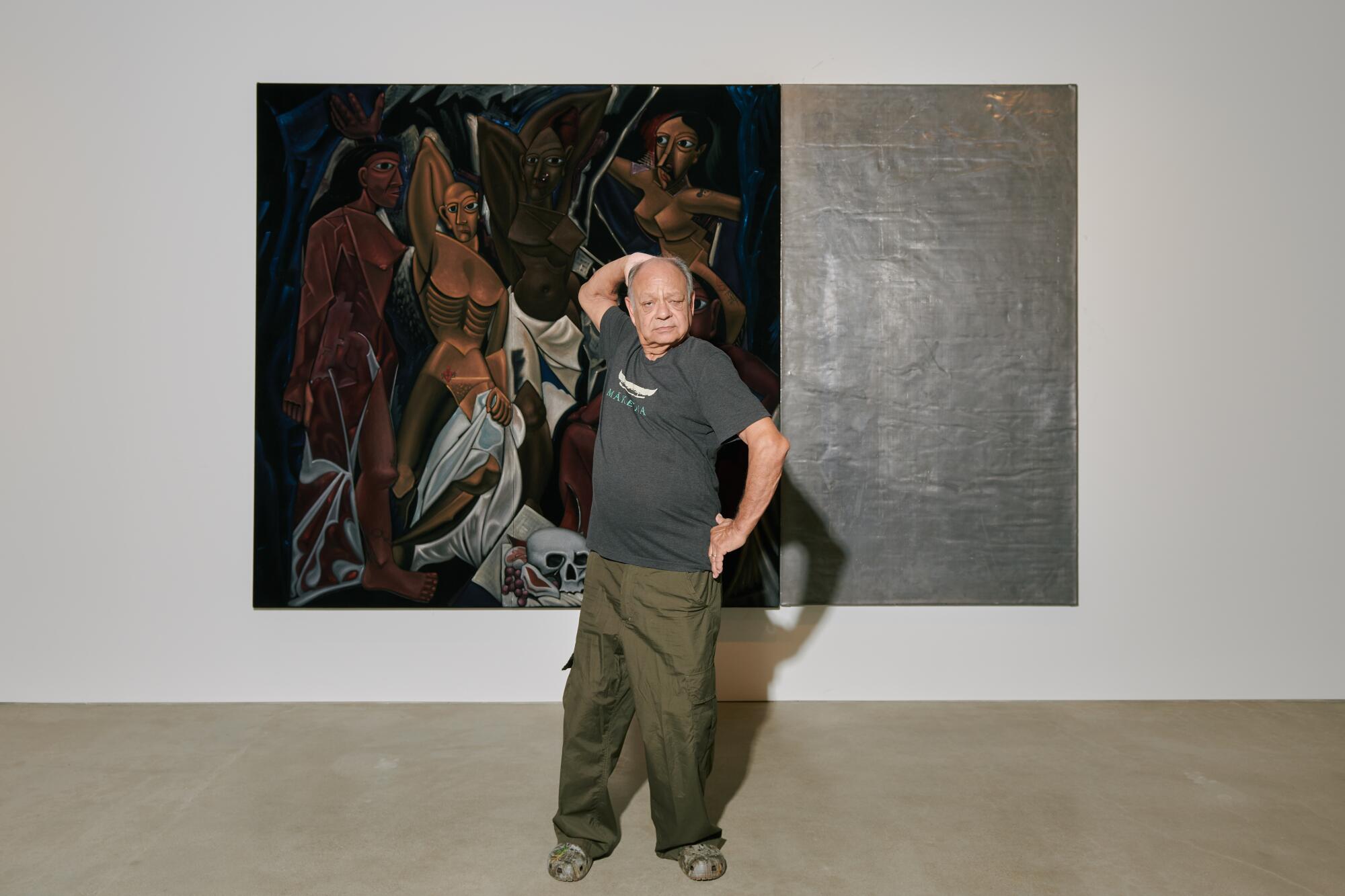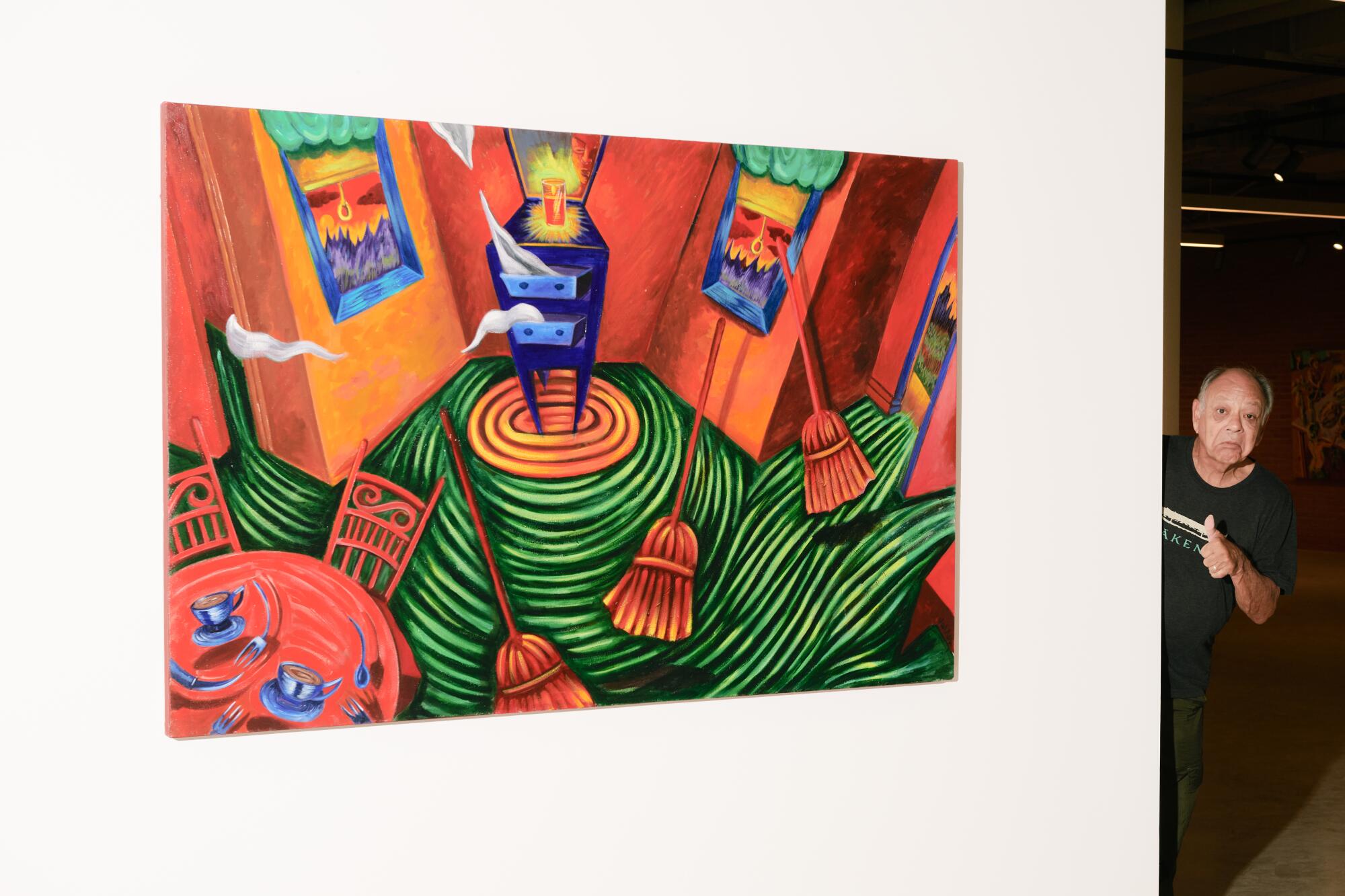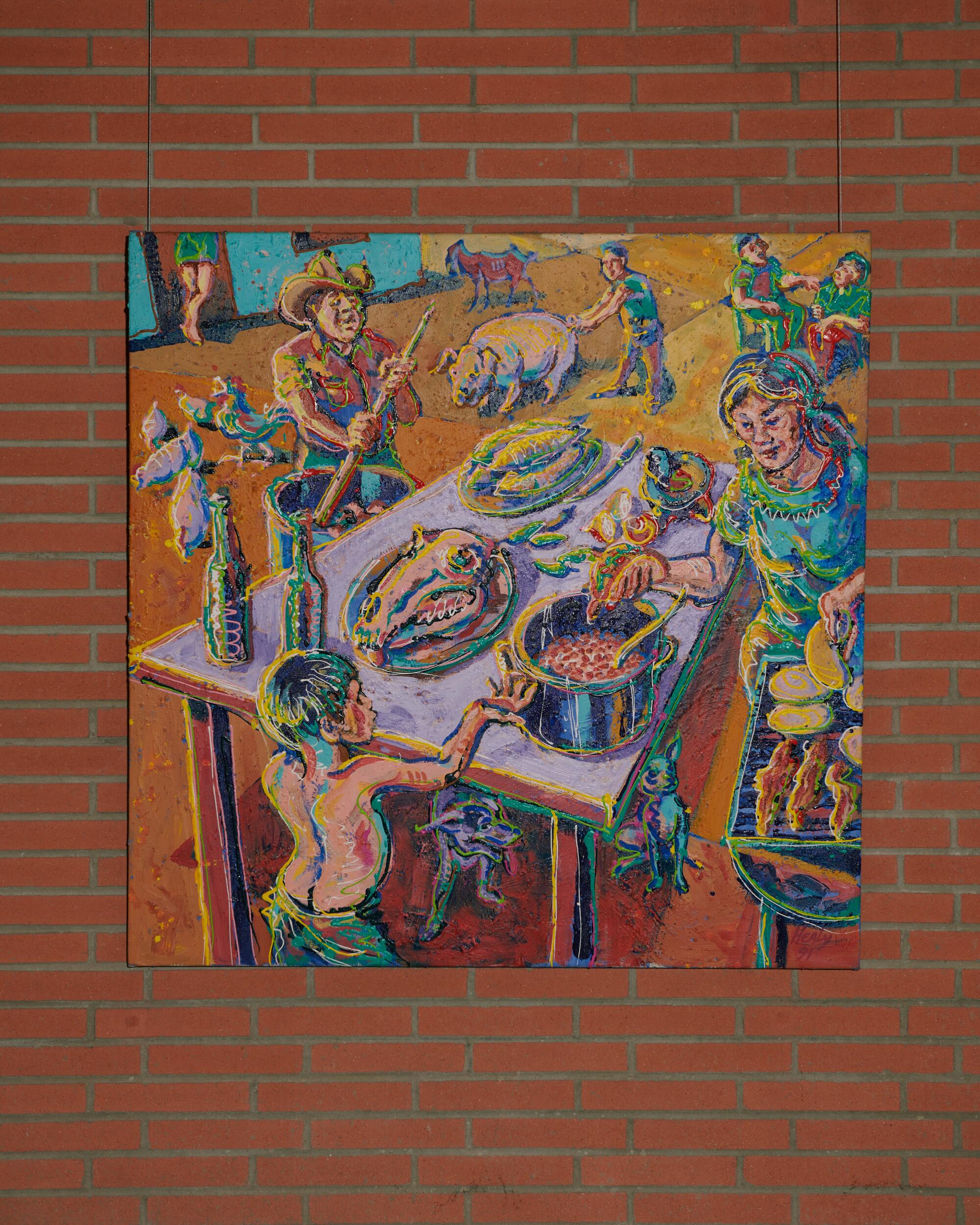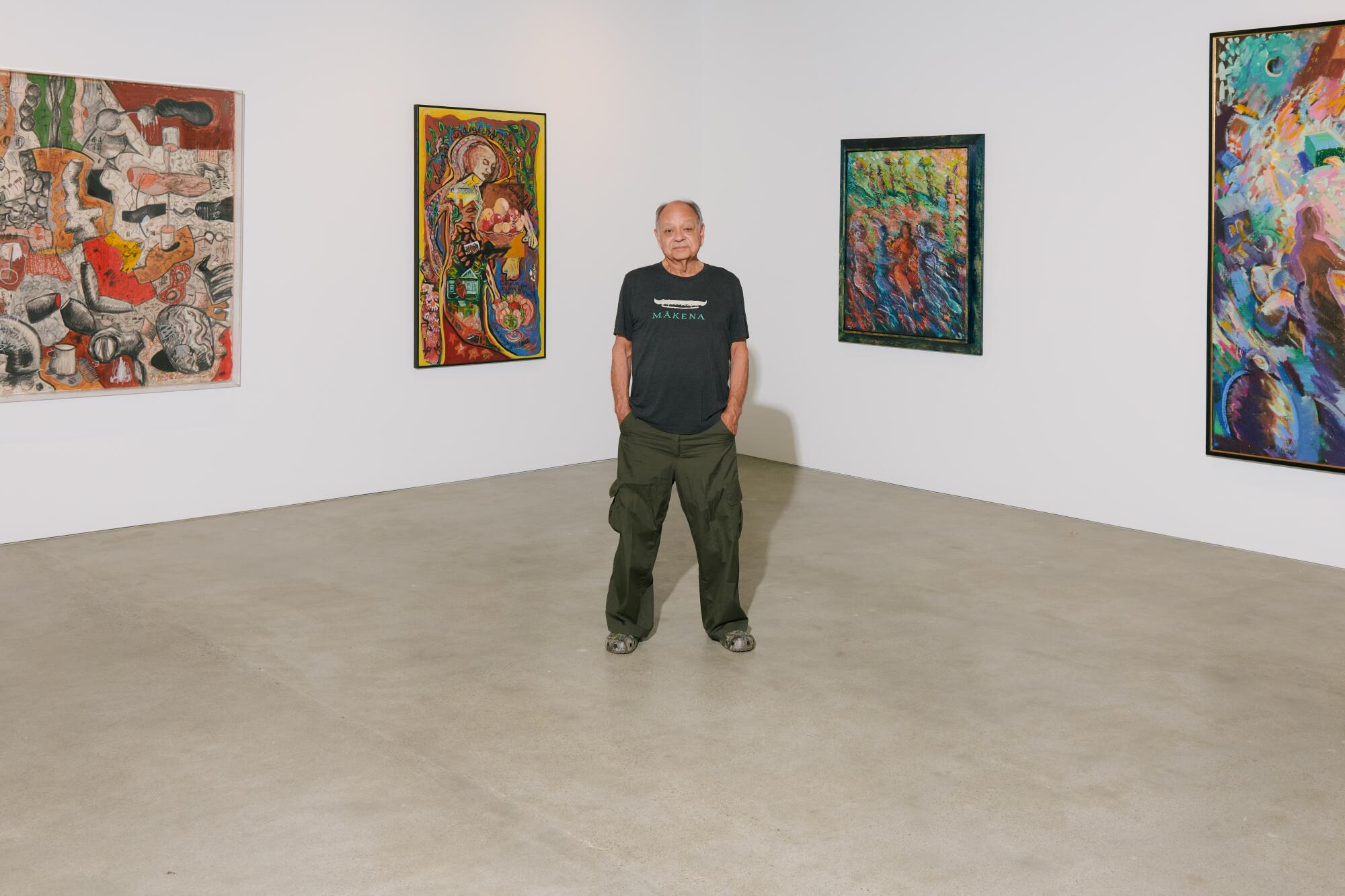
- Share via
Growing up, Cheech Marin was always a collector.
It started with marbles. Later on, it was baseball cards, then eventually stamps. Now, at 75, he’s collected enough art to fill an entire museum.
“I’ve collected things since I was a kid,” says Marin, arguably best known as half of the stoner comic duo Cheech and Chong. “I always had some type of collection going.”
Marin purchased his first art pieces in the mid-1980s with the money he earned from his success in comedy and big-screen hits such as “Up in Smoke” and “Cheech and Chong‘s Next Movie.” He began by collecting Chicano-inspired Art Deco and Art Nouveau pieces in “an undervalued little deal at the time.” Around the time his Art Nouveau collection grew in size — and value — Marin says he discovered artwork made by Chicano painters and recognized their artistic styles right away.
Thirty-seven years later, Marin continues to collect from predominantly Chicano artists, and has created what many consider to be the largest private collection of Chicano art in the world.
More than 550 paintings, drawings, sculptures and photographs from Marin’s personal collection will be on permanent rotation at the Cheech Marin Center for Chicano Art and Culture of the Riverside Art Museum, starting with an inaugural exhibition of 100 pieces beginning June 18.
Nicknamed “the Cheech,” the 61,420-square-foot, two-story art museum and education center resides in what used to be the downtown Riverside Public Library, and will be displaying works by artists Chaz Bojorquez, Judithe Hernández, Frank Romero, Patssi Valdez and others.

The museum is a first, not just for Marin but for the nation. It’s considered the only permanent art space to exclusively showcase Chicano and Mexican American art in the country.
“You don’t have to be Chicano to love and appreciate this work,” Marin says. “Just like I don’t have to be French to appreciate Impressionism or German to appreciate Expressionism. We recognize it as part of the conversation in the history of art. And now we are part of that conversation in a more concentrated effort than we’ve ever had before.”
The center has been underway for five years, and will be staffed and directed by the Riverside Art Museum. The city of Riverside will fund $1 million annually under a 25-year contract to cover operating costs. Renovation costs for the former library came to around $13.3 million, subsidized by state grants and private donors.
Despite passing on a 4-0 vote in the City Council in January, some councilmembers were reluctant about the funding plan for the facility. Councilman Chuck Conder called the city’s 25-year financial commitment to the museum a “betrayal” of city taxpayers, according to the Press-Enterprise. In his criticism, Conder cited the city’s financial challenges, including a costly court decision from 2020 that could end up costing Riverside up to $32 million a year.
Two other councilmen, Andy Melendrez and Ronaldo Fierro, abstained from voting, citing conflicts of interests. Both own property within 500 feet of the museum.
The Cheech is expected to bring in an estimated $3 million in annual revenue to the city, and museum staff are anticipating around 100,000 visitors each year.
A rapidly growing city 60 miles east of Los Angeles, where more than half of the population identifies as Chicano, Riverside is the sixth-largest Hispanic/Latino county in the U.S. — and a perfect fit for the Cheech, Marin said.

“This is a new layer of cultural awareness of the people who actually live here, which hadn’t been done before,” says Marin, who grew up in South L.A. “This city was set up for this.”
Riverside city officials ultimately agreed. In 2017, Marin’s touring collection, “Papel Chicano Dos: Works on Paper From the Collection of Cheech Marin,” visited the Riverside Art Museum.
The exhibition drew record-breaking attendance to the museum. City officials visiting the exhibition told museum staff they were blown away by the line of visitors out the door, says Esther Fernandez, artistic director of the Cheech.
“It was obvious something spurred in the community. It spoke to a need,” Fernandez says. “So we said, we need to do this. We need to talk to Cheech. We need to figure out a way that we can have this kind of showing.”
In addition to the 100 artworks initially on display at the Cheech, the rest of Marin’s personal collection will be housed in a storage facility at the museum or offered out on loan to other institutions. Marin’s art collection has already done more than 50 museum tours nationwide and globally, but the Cheech will be its first permanent home.
The Cheech also will feature temporary exhibitions on its upper level, starting with “Collidoscope: de la Torre Brothers Retro-Perspective,” a 70-piece exhibit highlighting the Baroque-style artistic collaboration between brothers and artists Einar and Jamex de la Torre; it will run until January. The most prominent piece is a 26-foot lenticular sculpture of an Aztec goddess that towers over visitors the moment they step foot into the Cheech.
Fernandez described staff members for the new museum feeling “overwhelmingly emotional” as they unwrapped each piece from the collection when it arrived from Marin’s house in Pacific Palisades.
“We received the collection over three or four days, and it was like the holidays, like Christmas morning,” Fernandez said. “We were opening gift after gift and [were] moved.”
Much of the artwork arriving at the Cheech comes straight from the walls of Marin’s home. Wayne Alaniz Healy’s “Una Tarde en Meoqui” (“An Afternoon in Meoqui”) is his favorite, he says: a brightly colored 32-inch painting he once described as “a backyard barbecue but it is Norman Rockwell with jalapeños.” It has adorned every dining room of every home he’s ever lived in, but like the rest of his art collection, he says, it’s never truly belonged to him.
“At every [tour] stop, I look at all the crowds that came out — crowds that some cities didn’t even know they had — and with each stop, I felt the collection leaving my hands,” Marin said. “It was not strictly mine. It was mine, but it wasn’t strictly mine anymore. It belonged to the people who were seeing it and whose story it was.”


More to Read
The biggest entertainment stories
Get our big stories about Hollywood, film, television, music, arts, culture and more right in your inbox as soon as they publish.
You may occasionally receive promotional content from the Los Angeles Times.











